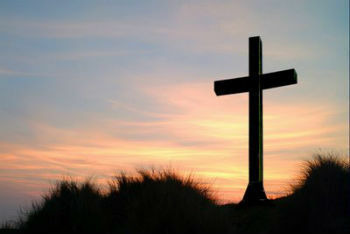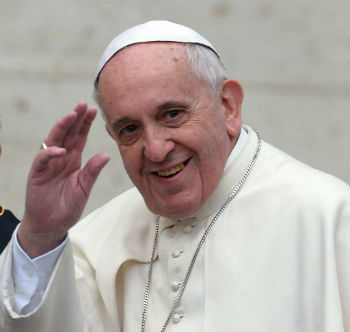O Catholicism it is a strand of Christianity, which believes that Jesus is the Savior of the world.
Catholics preach salvation from sin through belief in Jesus, the incarnation of God made man.
Origin

The cross is the ultimate symbol of Catholicism
Jesus was born in a small town called Nazareth. Around the age of 30, he began to preach and attract disciples, who recognized him as “Christ”, which means “anointed” in Greek.
His teachings also made enemies. Condemned by Jews and Romans, he was tried and sentenced to death on the cross. His disciples claim that he would have risen, that is, conquered death.
His disciples and apostles preached their doctrine that clashed with the paganism, polytheism and certain moral practices of the Roman Empire. So a long period of persecution followed.
This would only end when the Edict of Milan was promulgated, around 313, which prohibited the persecution of Christians.
From then on, Christianity began to grow, until it became the official religion of the Roman Empire, in 392.
Know more:
- Jesus Christ
- Christianity
Roman Catholics and Orthodox Catholics

The Pope is the symbol of unity among Roman Catholics and currently, Francis I holds this post
The division between Roman Catholicism and Orthodox Catholicism arose out of the dispute between the Bishop of Rome and the patriarchs of the east over how the church was organized. There was also a theological quarrel about the Holy Spirit.
This episode, dated 1054, is known as the schism of the east.
Unable to reconcile these antagonistic views, the leaders of each church excommunicate each other. Thus, the Roman Catholic Church and the Catholic Orthodox Apostolic Church.
While the Roman Catholic Church follows the Pope's directions, in the Orthodox Church, the local bishop has the last word. So we have the Russian Orthodox Catholic Church, the Bulgarian Orthodox Catholic Church, etc.
Both worship the saints. However, the first ones venerate them using sculptures, paintings, prints, etc.. On the other hand, the seconds do not admit three-dimensional images and their churches are covered with paintings.
Read more at Iconoclastic Movement.
Another characteristic that distinguishes them is the fact that a married man can become a priest, with his wife's consent. In the Roman Catholic Church this would not be possible, as celibacy is mandatory for priests.
The Orthodox do not share with the Romans the existence of purgatory, for them there is only heaven and hell.
Read more:
- patristic
- Christian Philosophy
- Medieval Philosophy
Catholicism in Brazil and the World
In Brazil, Catholicism is the religion that has the largest number of believers and was brought in at the time of its colonization.
Via Company of Jesus, the natives were taught and catechized in the Roman religion. Later, the Franciscans and other religious orders settled in Brazil.
Catholicism represents the largest religious community in the world, and its presence is greater in Europe and America.
Its headquarters are in the Vatican and its top leader, currently, is Pope Francis.
Popular Catholicism and Social Catholicism
Popular Catholicism is present in the less favored areas.
It was brought to Brazil by the simpler Portuguese, who did not belong to the elite. Here it mixed with the beliefs of the Indians and black slaves.
Praying holding the garment of a saint, making promises and sympathies, among others, are practices that characterize popular Catholicism.
Social Catholicism, in turn, arose from the concern shown by Pope Leo XIII with the social and economic issues, raised especially by the exploitation of workers in the capitalism.
From this concern, social doctrine became part of the teachings of the Catholic Church.
Likewise, in Brazil, there is a mixture of religions of African origin such as the Candomblé and the Umbanda with Catholicism.
Catholic Beliefs
- The source of Catholic faith is the Bible and the Oral Tradition of the Church;
- Catholics believe in the Holy Trinity, three persons - Father, Son and Holy Spirit - who form one God.
- They believe in the intercession of the Virgin Mary and the saints, who were people who lived according to biblical teachings.
- Every Sunday and holy day, Catholics must attend Mass, where the Eucharist is celebrated and excerpts from the Bible are heard and commented on by a priest.
- Believers believe they receive God's grace through receiving certain rituals, called sacraments, throughout the Christian life. There are seven sacraments: Baptism, Confirmation, Eucharist, Confession, Holy Orders, Matrimony and Extreme Unction.
Catholicism and Protestantism
In 1517, with the publication of the 95 theses of Martin Luther, Catholicism is no longer the only known strand of Christianity in Europe.
Via Protestant Reformation a new way of interpreting the Bible and worshiping God emerged.
Protestants keep intact the belief that Jesus is the Son of God and Savior of the world. However, they abolished the cult of saints, the real presence of Christ in the Eucharist and started to use the vernacular language and not Latin in their rites.
These ideas quickly found adherents and other intellectuals who deepened Luther's ideas as Calvin, Zwiglio, Wesley, among many others.
Know more:
- What was the Gregorian Reformation?
- medieval church
- Counter-Reform
- Council of Trent
- Religious intolerance
- Mother Teresa of Calcutta
